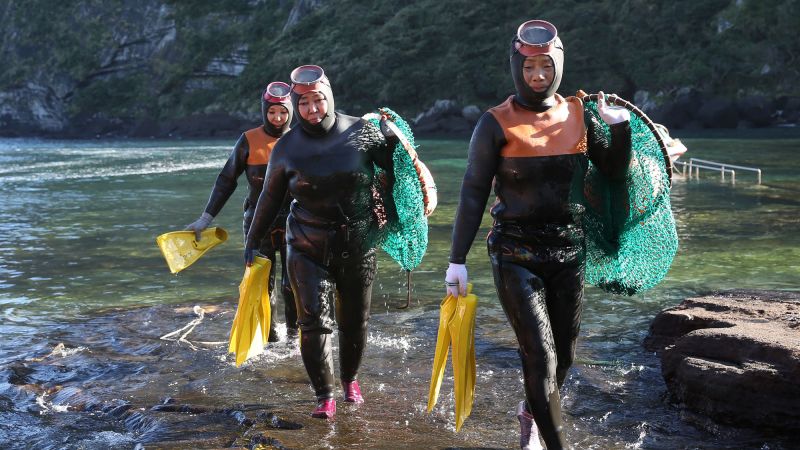**Exploring the Haenyeo: A Unique Community of Female Divers**
Nestled in the vast waters off the southern tip of the Korean Peninsula lies Jeju Island, an enchanting locale famed for its breathtaking vistas and rich marine biodiversity. Approximately 50 miles (80 kilometers) from the mainland, this island is home to a remarkable group of women known as the Haenyeo. Their extraordinary ability to dive deep into the ocean without any breathing apparatus has earned them a celebrated reputation, balancing tradition, culture, and remarkable physical prowess.
The Haenyeo have been practicing a unique form of free diving for centuries. They collect a variety of marine delicacies, including sea urchin, abalone, and excess seafood from the ocean floor, often diving as deep as 60 feet (18 meters) multiple times in a single day. This impressive feat is not limited to a select age group; women in this community dive throughout their lives, right from pregnancy to their senior years, all while donning only wet suits for protection against the elements.
Dr. Melissa Ann Ilardo, a geneticist and assistant professor at the University of Utah, highlights the remarkable matrilineal tradition among the Haenyeo. For thousands of years, mothers have passed down their knowledge of diving to their daughters, forming a unique bonding experience through which they collect seafood collectively. With such an extraordinary water affinity, it is clear that these women spend an unmatched percentage of their time submerged.
Intrigued by the Haenyeo’s remarkable abilities, Dr. Ilardo and her research team from South Korea, Denmark, and the United States sought to uncover the biological basis behind their impressive underwater capabilities. A notable area of inquiry was whether hereditary genetic traits or the impact of grueling lifelong training influenced their physical performance underwater.
Their research findings, published in the scientific journal *Cell Reports* on May 2, revealed genetic adaptations that enable the Haenyeo to endure the considerable physiological stress associated with free diving. These discoveries could potentially pave the way for advanced treatments for blood pressure disorders, raising new hope in medical science.
Jeju Island itself, often referred to as the Hawaii of Korea, boasts an abundance of resources along its extensive coastlines, making it ideal for populations like the Haenyeo to thrive while utilizing its natural offerings. Diving has formed an integral aspect of Jeju’s culture for many generations, though the reasons for its gender segregation remain somewhat obscure. Potential theories include a historic tax on male divers or a shortage of men in the community.
Yet, this storied tradition is facing an uncertain future. With the current cohort of Haenyeo averaging around 70 years old, there is concern that the matrilineal diving practice may soon become extinct, especially as younger women seem disinterested in taking up this ancestral trade.
In their study, Ilardo and her colleagues analyzed three groups of women: 30 divers from the Haenyeo community, 30 non-diving women from Jeju, and 31 women from mainland South Korea. The participants’ heart rates, blood pressure, spleen sizes, and genomic sequences were compared to draw insight into the physiological and genetic markers inherent to the Haenyeo. A unique challenge involved replicating the underwater stress experienced by divers for those with no prior diving experience. By conducting controlled experiments that simulated diving conditions, the researchers strove to replicate the physiological environment that Haenyeo divers encounter.
Through innovative techniques such as simulated dives, where participants held their breath while immersing their faces in cold water, the research team was able to gather vital data. The investigation unveiled that both Haenyeo divers and non-divers from Jeju displayed more than four times the likelihood of carrying a genetic variant associated with lower blood pressure compared to their mainland counterparts. This discovery prompted speculation that this genetic trait may have evolved as a protective mechanism for women diving during pregnancy, an era when elevated blood pressure poses risks.
Furthermore, the researchers uncovered that Jeju participants had an increased genetic variation related to cold and pain tolerance, although it remains unclear whether this directly contributes to the Haenyeo’s year-round diving capabilities. The ways in which these women have traditionally faced frigid waters in cotton clothing until the late 1980s illustrate an intriguing determination worth further exploration.
Crucially, the study demonstrated that the Haenyeo’s accomplishments are not solely attributed to genetic factors. Their training and experiences revealed slower heart rates during diving exercises compared to non-divers, allowing them to conserve oxygen more proficiently while submerged. The significance of their heart rate drops during dives points to training as a major contributing factor unique to the Haenyeo’s adaptation.
Comparatively, Dr. Ilardo’s earlier studies on other free diving communities, such as the Bajau people of Sulawesi, Indonesia, identified various genetic adaptations that facilitate prolonged periods without oxygen. While the Haenyeo also shared some of these physiological traits, their larger average spleen size was insignificant once taking factors like age



